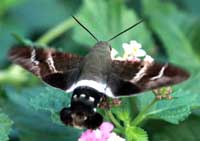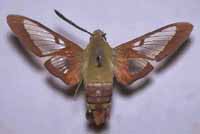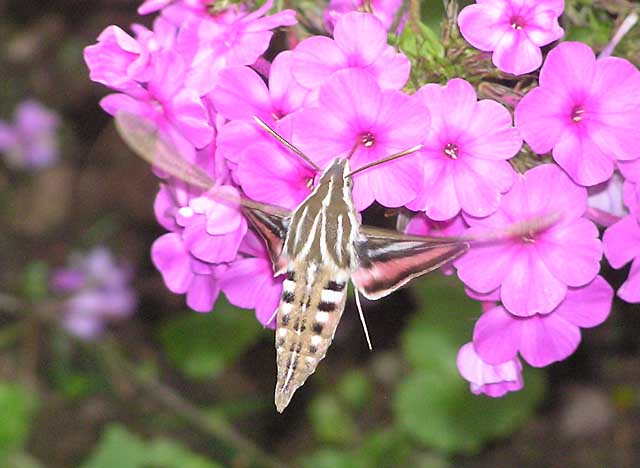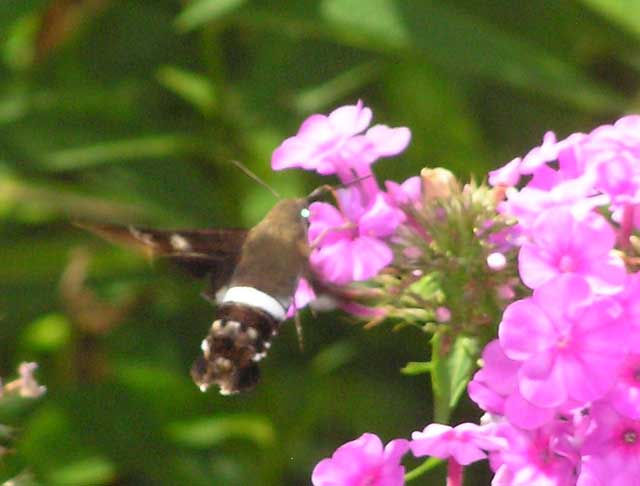Sphinginae subfamily
Sphingini tribe:
 |
Agrius cingulata,
WO Pink-spotted hawkmoth,
very rare stray.
This species is a strong migrant and adults nectar from
deep-throated flowers including moonflower (Calonyction aculeatum),
morning glory (Convolvulus), honey suckle (Lonicera)
and petunia (Petunia species).
|
 |
Ceratomia amyntor
WO,
the Elm Sphinx or Four-horned Sphinx.
The upperside of the forewing is brown with dark brown and white markings including a white costal area near the wing base, dark streaks along the veins, and a white spot in the cell.
Larvae feed on Elm (Ulmus), birch (Betula), basswood (Tilia), and
cherry (Prunus). |
 |
The upperside of the forewing is pale brownish gray with wavy black and white
lines and a black-outlined white cell spot. |
 |
The upperside of the forewing is gray with heavy black bands.
The upperside of the hindwing is brownish gray with no markings.
If you have pines, you
probably have this species. It also flies on P.E.I.
|
 |
This large bodied moth flies in tobacco fields and vegetable gardens
(potatoes, tomatoes) and wherever host plants are found.
probably present |

|
Sphinx canadensis
WO,
Sphinx canadensis, the Canadian Sphinx, is not common, and is not
often reported anywhere,
and may be present in Brown County.
Larval hosts are white ash (Fraxinus americana) and blueberry
(Vaccinium).
|
 |
Sphinx chersis
BAMONA, the Northern Ash Sphinx or Great Ash Sphinx
The upperside of the forewing is soft dark gray to blue-gray
with a series of black dashes, one of which reaches the wing tip. |
 |
The lower forewings are predominantly brownish-yellow with a
fairly wide dark bar along the inner margin. At rest the wings
hug the body, giving the moth a long slender look.
|
 |
If you have blueberries in the woods, then you probably have the
Poecila Sphinx. They are probably widespread throughout Wisconsin,
but are very much under reported. |
Smerinthini Tribe:
 |
The adults are also highly variable; sometimes wings of an individual may be all one color or may have several colors, ranging from pale to dark brown, and may have a white or pink tinge.
See the file for the female; she is different. |
 |
The outer margin of the forewing is quite wavy. There is a dark cell
spot and a dark oblique line mid wing from the costa almost to the
inner margin. Basic ground colour is pinkish brown. Flight would
be June-July. |
 |
This small species is possibly in Brown County. This species
ranges
across North America.
The hindwings have a small blue eyespot ringed with black on a
yellow background.
|
 |
Pachysphinx modesta
BAMONA,
the Modest Sphinx or Poplar Sphinx,
This large poplar/willow feeder is not reported in Brown County,
but it is likely present.
They are a heavy bodied species.
|
 |
Smerinthus cerisyi
WO, the Cerisyi's
Sphinx or One-eyed Sphinx, Larvae feed on poplars and willows.
Flight would be from late May-July as a single brood.
probably present
|
 |
Smerinthus jamaicensis closely resembles Smerinthus cerisyi, but
jamaicensis is much smaller with larger blue patches on more
vibrant and deeper purple in the lower wings.
|
Macroglossinae subfamily
Dilophonotini Tribe:
 |
Aellopos titan
EB; rare stray from further south, itan Sphinx.
The body is dark brown with a wide white stripe across the abdomen.
The wings are dark brown. It is very similar to above species, but the
upperside of the hindwing has pale patches along the costa and inner margin. rare |
Aellopos titan, Chute, September 14, 2013, Ed Burton.
See Hemaris comparison to help distinguish
the next three species.
 |
Hemaris diffinis
WO, the Snowberry Clearwing or Bumblebee Moth,
The moth flies along forest edges and in meadows, gardens and
brushy fields. Day-flying adults nectar at lantana, dwarf bush honeysuckle,
snowberry, orange hawkweed, thistles, lilac, Canada violet, etc. |
 |
Hemaris gracilis
WO, The Slender Clearwing or Graceful
Clearwing
This day flier is not commonly reported, but it might be present in
Sheboygan County. Generally it is reported more to the east.
unlikely |
 |
Hemaris thysbe
BAMONA, the Hummingbird Clearwing
It is not difficult to see why many gardeners would mistake an Hemaris thysbe moth for a small hummingbird as it hovers, sipping nectar
from flowers through a long feeding tube. |
Philampelini Tribe:
 |
Adults nectar from flowers of Japanese honeysuckle
(Lonicera japonica), petunia (Petunia hybrida), mock orange
(Philadelphus coronarius), and phlox (Phlox).
Note the differences between this moth and the Pandorus Sphinx. |
 |
If you have Grape or Virginia Creeper nearby, then you probably have
this species. I often get asked to identify larvae from areas where
they have not previously been reported. more southerly |
Macroglossini Tribe:
 |
This day flier is widely distributed. If you have Virginia Creeper,
you might have the Nessus Sphinx. Two bright, distinct, narrow
yellow bands are often visible on the abdomen.
|
 |
They are common in New Jersey and common
here on Prince Edward Island.
You will often see this species listed as Darapsa pholus,
especially in older literature.
|
 |
Darapsa myron
WO, the Virginia Creeper Sphinx or the
Grapevine Sphinx
It is widely reported in southern Michigan and in southern Ontario.
It may be present, although a bit unlikely.
|
 |
This species has not been recorded in Brown.
It is seen in southern Ontario, however, and in central and
southern Wisconsin and might be present. |
 |
Hyles lineata
EB, the White-lined Sphinx
Adults usually fly at dusk, during the night, and at dawn, but they
also fly during the day over a wide variety of open habitats
including deserts, suburbs, and gardens. |
Hyles lineata, September 14, 2013, Grand Chute, Ed Burton
 |
This moth is very much under reported on USGS. It is a
rapid day flier so is probably not in too many collections.
Grape is a popular larval host.
|
|
|


